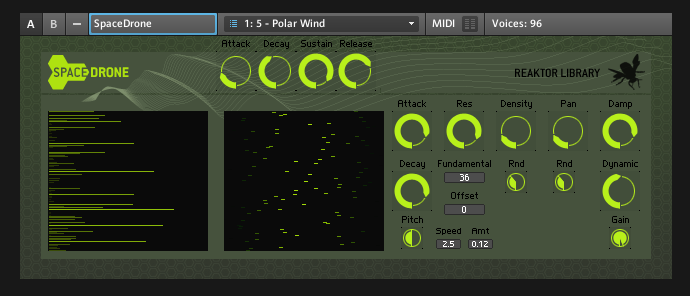Note: from now on buying Loupe on this page automatically gets you a copy of the new Loupe 2 as well!
I’m pleased to release three new granular sampling instruments for Reaktor: Frame 2, Loupe and Mirage.
Each one has its own character and purpose. Frame 2 is a simple looping sampler designed for live control of loop points and other parameters. Here’s the cheat sheet:
Frame is free and you can download it here. This is an update to the original Frame – it adds a nicer GUI, clearer graphical start and end points on the waveform, and some small under the hood enhancements. Here’s a bit of improv to hear how it sounds:
The next instrument is Loupe – a polyphonic looping slicer for quickly mapping arbitrary (that is, non-beatsliced) sections of a sample to different MIDI keys.(note: purchasing this version now gets you Loupe 2 as well)
How it works: hit a MIDI key and hold, then click and drag to set loop location and length in one gesture, then click and drag in the XY controllers to set pitch, pan, gain, envelope, reverse / forward and filter parameters. Each slice / note has its own settings. It’s great for remixing. By default it has four voices but set more in the instrument properties if you want ’em.
It’s primarily intended for mangling melodic samples but percussion works too. Here’s what it sounds like:
Like Frame 2, Loupe is self documenting through extensive tool-tips. None of the controls are too small or too fiddly. You can learn how to use it in minutes but I think you’ll find a million uses for it. This reflects my instrument building philosophy that an instrument should give you musical leverage without making you feel like you’re endlessly flipping switches on a room-sized computer from the 1960s.
I use a Maschine MIDI controller and like to map each row of four pads to musically related slices so I can play a particular idea or phrase on different rows. A different pad (or MIDI key) can have the same slice but with a different length, or a different pitch, or reversed and panned differently, or all of the above.
Loupe can be downloaded here. A password to unlock the archive is $20 USD and can be purchased here:
Loupe 
The third weapon in the sampling pack arsenal is Mirage.
Mirage is a granular sampler inspired by three things – the music of Tim Hecker, my laziness, and my disorganization. 😉 It’s sort of like a trapper keeper for ambient sampling. It lets you select an area of a sample to work with, then allows you to set your granular parameters, per-voice filter settings and pan, voice retrigger frequency, and other things – and crucially, it remembers the pitches you play and saves them with a snapshot when using the “Hold” button.
This creates a host-independent sketchbook for sound design and composition. When you stumble upon a magic combination of samples, settings and notes, everything saves together in the instrument for later recall, refinement and mixing.
When you DO find something magical, you’ll find you can just sit there and listen to a snap for an indecent amount of time as the separate voices crawl across the waveform hypnotically.
Here’s what it sounds like:
Mirage is aimed at a different musical goal than Loupe – you might say that if Loupe is a paintbrush for cubism then Mirage is one for impressionism. Both instruments differ, then, from the typical granular sampling feel and sound which in my mind is more like pointillism.
Mirage can be downloaded here – A password to unlock the archive is $15 USD and can be purchased here:
Mirage 
If you want to know more leave a question in the comments or hit me up on twitter.
Special thanks to Felix Petrescu for beta testing Loupe and helping to make it a better instrument!
NOTE: these ensembles are built for the latest full version of Reaktor – version 5.5.1 – it’s a free update if you have 5.15.
Several newbies have asked me about adding samples. See here and the resource page.












